The Featured Creatures collection provides in-depth profiles of insects, nematodes, arachnids and other organisms relevant to Florida. These profiles are intended for the use of interested laypersons with some knowledge of biology as well as academic audiences.
Introduction
The tobacco hornworm, Manduca sexta (L.), is a common pest of plants in the family Solanaceae, which includes tobacco, tomato, pepper, eggplant, and various ornamentals and weeds (del Campo and Renwick 1999). Caterpillars in the family Sphingidae are known as hornworms, due to their worm-like body shape and the presence of a small, pointed "horn" at their posterior (Figure 1). The adult stage of Manduca sexta is a heavy-bodied moth that resembles a hummingbird, and Manduca adults are commonly referred to as hawkmoths or hummingbird moths (Figure 2). The larval stage (hornworm) of this species is more often encountered, as it resides on the host plant during the day and can cause significant defoliation of economically important crops.
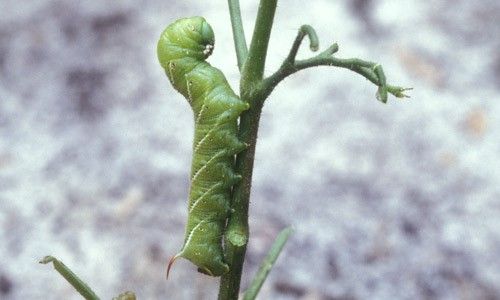
Credit: Lyle J. Buss, UF/IFAS
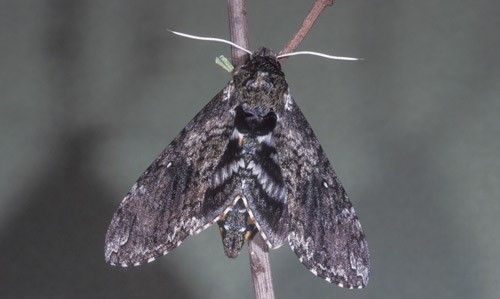
Credit: Lyle J. Buss, UF/IFAS
This species may be confused with the tomato hornworm, Manduca quinquemaculata (Haworth), a closely related species that also preferentially feeds on solanaceous plants. These species can be distinguished from one another by comparing the markings on the body of larvae and on the abdomen of the adults. In addition to its pest status, Manduca sexta is an important model organism in the field of entomology, particularly insect physiology (Koenig et al. 2015). Manduca sexta has been used for a series of important studies that contributed to the understanding of insect endocrinology and development (Nijhout and Williams 1974, Bollenbacher et al. 1981). Specifically, this species was used to investigate the interactions between endogenous hormones and environmental cues that signal development through multiple instars and the onset of pupation (Riddiford et al. 2003).
Distribution
The tobacco hornworm is found throughout the United States (north to the southern portion of Canada), Central America, and the Caribbean (Cranshaw 2004). This species is more commonly encountered in southern states, but its range may overlap with the closely related tomato hornworm, Manduca quinquemaculata, which predominates in the northern United States (Cranshaw 2004).
Description
Eggs
The eggs of Manduca sexta are deposited on the leaves of the host plant and hatch one to three days after oviposition. Eggs are about 1 mm (< 1/32 in) in diameter, greenish in color, and slightly iridescent (Deel 1999).
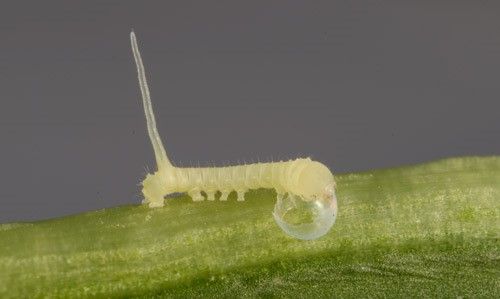
Credit: Lyle J. Buss, UF/IFAS
Larvae
The common name tobacco hornworm refers to the larval stages of Manduca sexta; the caterpillars are robust and bright green, with white, diagonal striped markings and a small protrusion (the "horn" in hornworm) on the last abdominal segment (Figure 4) (Cranshaw 2004). Manduca sexta larvae undergo four or five instars, gradually increasing in size to about 8 cm (~3 in) in length in the final instar (Deel 1999, Encyclopedia of Life 2017). The tobacco hornworm looks very similar to tomato hornworm, Manduca quinquemaculata (Figure 5), and their range and host plants can overlap. Body markings and horn coloration can be used to distinguish between the two species. The tobacco hornworm has whitish diagonal lines on the body and a reddish horn, whereas the tomato hornworm has V-shaped markings on the body and a black horn (Cranshaw 2004).
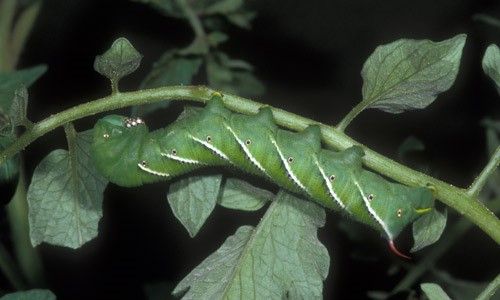
Credit: James Castner, UF/IFAS
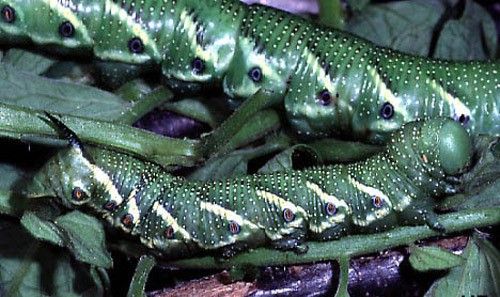
Credit: John Capinera, UF/IFAS
Prepupae and pupae
At the end of the final larval instar, the hornworm enters what is considered the prepupal stage. This stage is characterized by wandering behavior and selection of a pupation site, followed by the formation of the pupal cell below the leaf litter or soil substrate. Once the pupal cell is excavated, the prepupal stage transitions into the pupal stage as the insect's cuticle hardens and darkens, forming the pupa. The pupa of Manduca sexta is a dark, reddish-brown color with a maxillary loop at the anterior end and a pointed posterior end (Figure 6) (Deel 1999). Depending on the time of year and number of generations (two is typical in most areas), overwintering may occur during this stage (Cranshaw 2004). The sex of Manduca sexta can be determined by looking for markings on the fifth instar larvae, the prepupae or the pupal case, or the adult (Willott 2003).
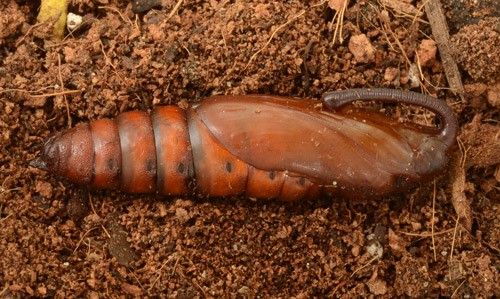
Credit: Lyle J. Buss, UF/IFAS
Adults
The adult stage of Manduca sexta is a robust, agile moth known as the Carolina sphinx moth or the tobacco hawkmoth (although the Entomological Society of America does not list an approved common name for the adult moth). Adults have a wingspan of 3.75 to 4.75 in (9.5 to 12 cm) for the forewings; hindwings are small in comparison (Lotts and Naberhaus 2017). The wings have a mottled pattern of white, brown, and black with distinct light and dark bands on the hindwings. When at rest, the wings fold back giving the moth a triangular shape and providing camouflage (especially when resting on trees with lichens) (Figure 1). The Carolina sphinx moth has six pairs of yellowish-orange spots (five large pairs of spots, with the posterior-most pair comparatively small) arranged vertically on the grayish-brown abdomen (Figure 7). The adult of the tomato hornworm (Figure 8) is similar in appearance but has five pairs of yellowish-orange spots (Cranshaw 2004, Lotts and Naberhaus 2017).
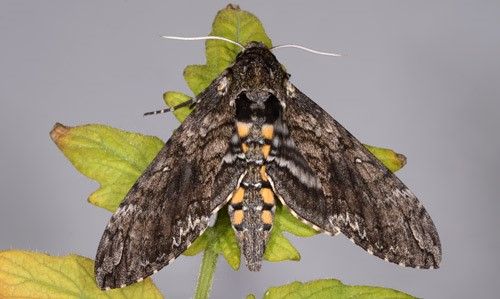
Credit: Lyle J. Buss, UF/IFAS
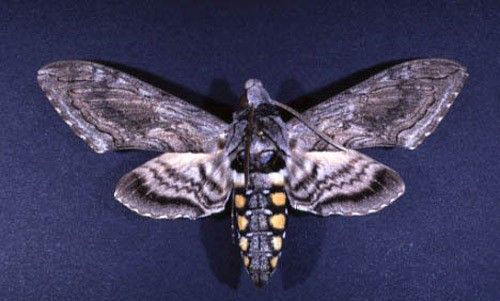
Credit: John Capinera, UF/IFAS
The adult moths are also referred to as hummingbird moths due to their tendency to fly nimbly between flowers, hovering over each to extract nectar with their long proboscis. Some moths in the Sphingidae family are considered to be beneficial pollinators, an interesting ecological role in contrast to the destructive nature of the larvae. After eclosing (emerging as an adult from the pupal stage), the moths are crepuscular (active at dawn and dusk) and obtain nectar from a variety of flowering plants. Females can produce eggs three to four days after emerging and mating, and each female can produce many eggs (some sources say up to 1,000) in her lifetime of several weeks (Deel 1999).
Description and Life Cycle
The tobacco hornworm is a specialist of solanaceous plants, like pepper, tobacco, and tomato. Plants in the family Solanaceae contain steroidal and triterpenoid glycosides, chemical compounds that play an important role in the biology of Manduca sexta (Haribal et al. 2006). One steroidal glycoside in particular, indioside D, was observed to induce feeding preference in native larvae, causing these individuals to specialize solely on solanaceous foliage (del Campo et al. 2001). Female moths select plants for oviposition based on chemical cues, such as odor, detected via their antennae (Reisenman et al. 2009, Spathe et al. 2013). Studies suggest that female moths will not oviposit on plant hosts that have already been infested and exhibit feeding damage, likely detecting a blend of plant volatiles released by the plant in response to the feeding (Reisenman et al. 2009, Spathe et al. 2013).
As mentioned earlier, this species has been used extensively as a model organism in experiments related to insect development, genetics, and behavior. In the lab they can be successfully reared on artificial diet. Manduca sexta larvae reared under laboratory settings will not feed exclusively on solanaceous plants, accepting plant tissue from a variety of other plants in different plant families. However, caterpillars reared initially on a solanaceous diet were significantly less likely to feed on non-solanaceous leaves, even when no other food option was presented (del Campo et al. 1999). Additional studies suggest that olfactory cues are supplemented by gustatory (taste-based) cues in Manduca sexta larvae, and that feeding preference is largely a function of early feeding experiences (Glendinning et al. 2009).
Both male and female adult moths feed on nectar from a variety of flowering plants. Adults are active at night, further strengthening the conclusion that larval host plants are located using chemical, rather than visual signals (Reisenman et al. 2009).
Larval host plants include Datura wrightii (jimsonweed), Nicotiana attenuata (wild tobacco), Proboscidea parviflora (devil's claw) (Spathe et al. 2013), Lycopersicon esculentum (tomato) (Reisenman et al. 2009), Capsicum annuum (bell pepper) (Fraser et al. 2003), and Solanum tuberosum (potato) (de Campo et al. 2001).
Host Plants
These insects feed only on solanaceous plants, most commonly on tomato and tobacco. They have been recorded on other vegetables such as eggplant, pepper, and potato, but this is rare. Several Solanum spp. weeds are reported to serve as hosts. Adults imbibe nectar from flowers of a number of plants and can be seen hovering about flowers at dusk.
Damage
The larval stages of Manduca sexta are voracious feeders. Larvae feed by consuming the leaves of solanaceous plants, often stripping entire leaves to the midrib and causing complete defoliating of the plants (Figure 9). Though considered a common garden pest, tobacco hornworm can cause significant economic damage to tobacco crops and occasionally tomato and potato crops. Larvae may feed on unripe, green fruit, leaving large wounds and exposing the fruit to opportunistic plant pathogens (Figure 10) (Cranshaw 2004).
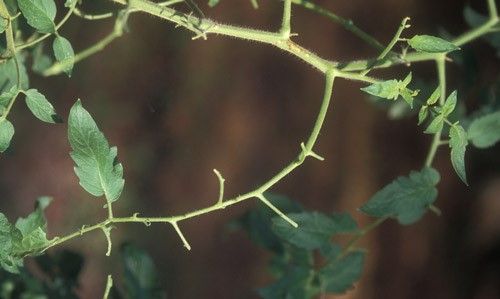
Credit: James Castner, UF/IFAS
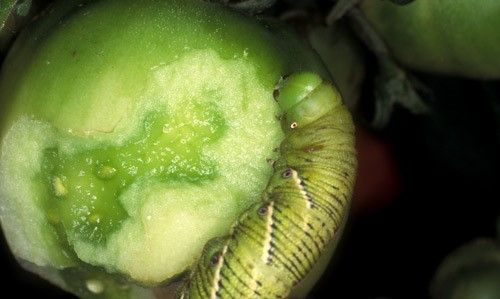
Credit: James Castner, UF/IFAS
Management
Tobacco hornworms can be controlled in various ways and immediate management is recommended if this pest is detected in a garden or field setting. In smaller operations, like a home garden, hand picking and destruction of the caterpillars is an effective way to reduce the population. This method of cultural control requires regular scouting of solanaceous plant species, looking for signs of feeding damage. The caterpillars themselves can be hard to see against the green foliage of the host plant, so careful monitoring of defoliation or the presence of frass (Figure 11) may be better indications of caterpillar presence.
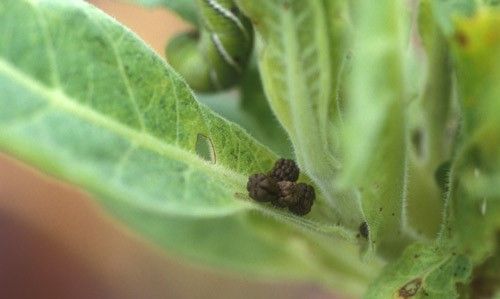
Credit: James Castner, UF/IFAS
Biological control is another method of management, using Bacillus thuringiensis (Bt), a naturally occurring soil bacterium that produces a protein that acts as a fatal endotoxin when consumed by Lepidopteran larvae (and the larvae of some other insect taxa). This product is widely available and safe for use around pollinating insects because it has to be consumed in order to be effective. Additionally, Bt is suitable for use in organic growing operations. This pesticide is more effective on earlier instar larvae, as a smaller amount must be consumed for effective control.
Tobacco hornworms have several natural enemies, including vertebrate species that feed on caterpillars, such as birds and small mammals, and insects like lacewing and lady beetle larvae that consume the eggs and early instar larvae. Wasps are a common predator of hornworms. Paper wasps and other insects that provision prey for their young will take hornworms from the host plant, paralyze them, and place them into the nest cells containing the wasp's eggs as a future food source. Parasitoid wasps, like Cotesia congregata, use hornworms as a food source for their developing young. These wasps deposit their eggs inside the hornworm's body and the larval wasps develop within the caterpillar, feeding on it as they progress through their life cycle. When pupation takes place, the immature wasps spin small, white, silken cocoons that protrude from the body of the still-living caterpillar (Figure 12) (Crockett et al. 2014). The cocoon-covered hornworms are a sight of great interest in the garden, and many fear that the parasitized caterpillars will have a negative impact on their garden. In fact, the opposite is true because the hornworm will eventually die and several adult wasps will emerge, mate, and seek out additional hornworm hosts for their eggs.
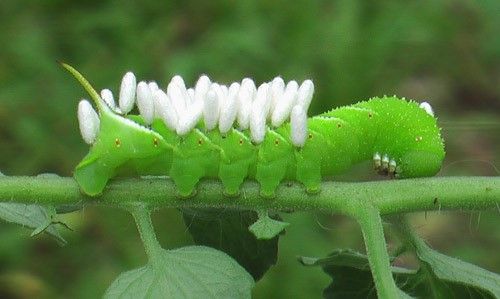
Credit: Lyle J. Buss, UF/IFAS
Selected References
Bollenbacher WE, Smith SL, Goodman W, Gilbert LI. 1981. Ecdysteroid titer during larval-pupal-adult development of the tobacco hornworm, Manduca sexta. General and Comparative Endocrinology 44: 302-306.
Campbell D. (2017). Manduca sexta, Carolina sphinx moth. Encyclopedia of Life. (1 October 2017)
Cranshaw W. 2004. Hornworms/Sphinx moths. Garden Insects of North America: The Ultimate Guide to Backyard Bugs. Princeton University Press, Princeton, New Jersey, USA. p. 146-149.
Crockett CD, Lucky A, Liburd OE. (2014). Cotesia congregata (Say), a parasitoid wasp. UF/IFAS Featured Creatures Document EENY-598. (2 October 2017)
Deel S. (1999). Tobacco hornworms. Research Link 2000, Carleton College, Northfield, Minnesota, USA.
del Campo ML, Renwick JAA. 1999. Dependence on host constituents controlling food acceptance by Manduca sexta larvae, Entomologia Experimentalis et Applicata 93: 209-215.
Fraser AM, Mechaber WL, Hildebrand JG. 2003. Electroantennographic and behavioral responses of the sphinx moth Manduca sexta to host plant headspace volatiles. Journal of Chemical Ecology 29: 1813-1833.
Glendinning JI, Foley C, Loncar I, Rai M. 2009. Induced preference for host plant chemicals in the tobacco hornworm: Contribution of olfaction and taste. Journal of Comparative Physiology A 195: 591-601.
Koenig C, Bretschneider A, Heckel DG, Grosse-Wilde E, Hansson BS, Vogel H. 2015. The plastic response of Manduca sexta to host and non-host plants. Insect Biochemistry and Molecular Biology 63: 72-85.
Lotts K, Naberhaus T. (2017). Carolina sphinx, Manduca sexta (Linnaeus, 1763). Butterflies and Moths of North America, http://www.butterfliesandmoths.org/ (1 October 2017)
Nijhout HF, Williams CM. 1974. Control of moulting and metamorphosis in the tobacco hornworm, Manduca sexta (L.): Growth of the last-instar larva and the decision to pupatae. Journal of Experimental Biology 61: 481-491.
Reisenman CE, Riffell JA, Hildebrand JG. 2009. Neuroethology of oviposition behavior in the moth Manduca sexta. International Symposium on Olfaction and Taste 1170: 462-467.
Riddiford LM, Hiruma K, Zhou X, Nelson CA. 2003. Insights into the molecular basis of the hormonal control of molting and metamorphosis from Manduca sexta and Drosophila melanogaster. Insect Biochemistry and Molecular Biology 33: 1327-1338.
Späthe A, Reinecke A, Olsson SB, Kesavan S, Knaden M, Hansson BS. 2013. Plant species and status-specific odorant blends guide oviposition choice in the moth Manduca sexta. Chemical Senses 38: 147-159.
Willott E. (2003). How to sex Manduca larvae and pupae. The University of Arizona. (2 October 2017)